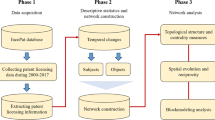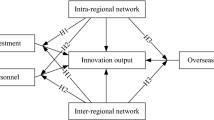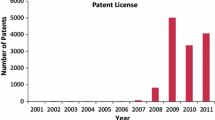Abstract
Only a few cases of systematic empirical research have been reported investigating collaborative knowledge production in China and its implications for China’s national and regional innovation system. Using Chinese patent data in the US Patent and Trademark Office (USPTO), this paper examines the geographic variations in intraregional, inter-regional and international knowledge exchanges of China from 1985 to 2007. Degree centrality reveals that intraregional and international collaborations are the main channels of knowledge exchange for the provinces and municipalities of China while inter-regional knowledge exchange is relatively weak. Besides, over the two decades, the knowledge exchange network has been expanding (connecting an increasing number of provinces and countries), becoming more decentralized (increasing number of hubs) and more cohesive (more linkages). A blockmodel analysis further reveals that the inter-regional network of China begins to show characteristics of a core-periphery structure. The most active knowledge exchange occurs between members of the core block composed by the most advanced provinces while the members of the peripheral block from less favored regions have few or no local and extra-local knowledge exchange. Building a strong knowledge transfer network would much improve the innovation capacities in less favored regions and help them break out from their “locked-in” development trajectories.







Similar content being viewed by others
Notes
There are two reasons for using the patent data from the USPTO and not those from the State Intellectual Property Office of P.R. China (SIPO). On the one hand, the data form of the DVD-ROM from USPTO is more accessible and easily transferred into an analyzable form than the original data form (.txt) of SIPO. On the other hand, due to abundant information of international collaboration, the patent data from USPTO are more suitable to analyze the international knowledge exchange of China than those of SIPO.
This file gathers all actual inventors’ names listed on a patent and all their private addresses and not the firms’ addresses. In this paper, we use co-inventors’ addresses to analyse voluntary collaborations and knowledge exchanges between regions.
The Chinese patents from the USPTO used in this paper include only a small portion of all Chinese patents because most of Chinese patents are granted by the SIPO. As a result, this paper just provides part of the picture of knowledge exchanges in the provinces and municipalities of China.
Records in which addresses of co-inventors are incomplete or not available were deleted from our database.
The international co-inventors among these collaboration cases were also included in order to explore the international knowledge exchange of China.
A loop is a special kind of line, namely, a line that connects a vertex to itself (De Nooy et al. 2005).
For two provinces, namely Xizang (Tibet) and Qinghai, no patents have been granted by the USPTO in the studied periods. Hence we just focus on the other provinces and municipalities of China. Besides Hong Kong, Taiwan and Macao, there were 30 provinces in China before 1997. Chongqing became the fourth municipality in 1997. Here, to make the analyses consistent, Chongqing is always treated as a city in Sichuan in the first and second periods, i.e., 1985–1992 and 1993–2000, and as the fourth municipality of China in the third period of 2001–2007. The collaborations between the provinces of mainland China and Hong Kong, Taiwan, and Macao are always considered as international knowledge exchanges.
China is a large country with a vast territory of 9.6 million km2, stretching from the temperate to subtropical zones. Geographically, it can be roughly divided into less favoured regions and favoured regions. Generally speaking, less favoured regions include the interior provinces in the central and western regions, such as Sichuan, Neimenggu, Guizhou, Ningxia and Shanxi, etc. Most of them are mountainous and poor. Favoured regions include most advanced municipalities and coastal provinces, such as Beijing, Shanghai, Jiangsu, Zhejiang, Shandong, and Guangdong. These provinces have more favourable natural conditions and are rich.
A k-core is a maximal subnetwork in which each vertex has at least degree k within the subnetwork (De Nooy et al. 2005). This notion helps to find cohesive subgroups.
Vertices that attract many links are called “hubs.”
A blockmodel is a simplified representation of a multi-relational network to show the relations among individuals with structural equivalence (Wasserman and Faust 1994).
Two vertices are structural equivalent if they have identical ties with themselves, each other, and all other vertices (De Nooy et al. 2005).
In a matrix, each row and column represent one vertex of the network. The intersection of a row and a column is called a cell of the matrix.
Density is the ratio of present lines to the maximum possible number of lines, excluding diagonal cells.
References
Amin, A., & Cohendet, P. (1999). Learning and adaptation in decentralized business networks. Environment and Planning D: Society and Space, 17, 87–104.
Balconi, M., Breschi, S., & Lissoni, F. (2004). Networks of inventors and the role of academia: An exploration of Italian patent data. Research Policy, 33, 127–145.
Bottazzi, L., & Peri, G. (2003). Innovation and spillovers in regions: Evidence from European patent data. European Economic Review, 47, 687–710.
Breschi, S., & Lissoni, F. (2004). Knowledge networks from patent data. In H. F. Moed, W. Glänzel, & U. Schmoch (Eds.), Handbook of quantitative science and technology research (pp. 613–643). Dordrecht: Kluwer Academic Publishers.
David, P. A., & Foray, D. (2002). An introduction to the economy of the knowledge society. International Social Science Journal, 171, 9–23.
De Nooy, W., Mrvar, A., & Batagelj, V. (2005). Exploratory network analysis with Pajek. New York: Cambridge University Press.
Ejermo, O., & Karlsson, C. (2006). Inter-regional inventor networks as studied by patent coinventorships. Research Policy, 35, 412–430.
Fleming, L., & Frenken, K. (2007). The evolution of inventor networks in the Silicon Valley and Boston regions. Advances in Complex Systems, 10(1), 53–71.
Henderson, R., Jaffe, A. B., & Trajtenberg, M. (1998). Universities as a source of commercial technology: A detailed analysis of university patenting, 1965–1988. Review of Economics and Statistics, 80, 119–127.
Hoekman, J., Frenken, K., & van Oort, F. (2009). The geography of collaborative knowledge production in Europe. Annals of Regional Science, 43, 721–738.
Hong, W. (2008). Decline of the center: The decentralizing process of knowledge transfer of Chinese universities from 1985 to 2004. Research Policy, 37, 580–595.
Hudson, R. (1999). The learning economy, the learning firm and the learning region: A sympathetic critique of the limits to learning. European Urban and Regional Studies, 6, 59–72.
Hussler, C., & Rondé, P. (2007). The impact of cognitive communities on the diffusion of academic knowledge: Evidence from the networks of inventors of a French university. Research Policy, 36, 288–302.
Jaffe, A. B., & Trajtenberg, M. (1999). International knowledge flows: Evidence from patent citations. Economics of Innovation and New Technology, 8, 105–136.
Jaffe, A. B., Trajtenberg, M., & Henderson, R. (1993). Geographic localization of knowledge spillovers as evidenced by patent citations. Quarterly Journal of Economics, 108, 577–598.
Katz, J. S. (1994). Geographical proximity and scientific collaboration. Scientometrics, 31(1), 31–43.
Katz, J. S., & Martin, B. R. (1997). What is research collaboration? Research Policy, 26, 1–18.
Liang, L. M., & Zhu, L. (2002). Major factors affecting China’s inter-regional research collaboration: Regional scientific productivity and geographical proximity. Scientometrics, 55(2), 287–316.
Liu, X. L., & White, S. (2001). Comparing innovation systems: A framework and application to China’s transitional context. Research Policy, 30, 1091–1114.
Meyer, M., & Bhattacharya, S. (2004). Commonalities and differences between scholarly and technical collaboration. An exploration of co-invention and co-authorship analyses. Scientometrics, 61(3), 443–456.
Moreno, R., Paci, R., & Usai, S. (2005). Spatial spillovers and innovation activity in European regions. Environment and Planning A, 37(10), 1793–1812.
Morgan, K. (1997). The learning region: Institutions, innovation and regional renewal. Regional Studies, 31, 491–503.
OECD. (1997). National innovation systems. Paris, France: Organization for Economic Co-operation and Development.
Powell, W. W. (1990). Neither market nor hierarchy: Network forms of organization. Research in Organizational Behavior, 12, 295–336.
Powell, W. W., White, D. R., Koput, K. W., & Owen-Smith, J. (2005). Network dynamics and field evolution: The growth of interorganizational collaboration in the life sciences. American Journal of Sociology, 110(4), 1132–1205.
Scherngell, T., & Barber, M. J. (2009). Spatial interaction modelling of cross-region R&D collaborations: Empirical evidence from the EU Framework Programmes. Papers in Regional Science, 88(3), 531–546.
Singh, J. (2005). Collaboration networks as determinants of knowledge diffusion patterns. Management Science, 51, 756–770.
Sorenson, O., Rivkin, J. W., & Fleming, L. (2006). Complexity, networks and knowledge flow. Research Policy, 35, 994–1017.
Tappeiner, G., Hauser, C., & Walde, J. (2008). Regional knowledge spillovers: Fact or artifact? Research Policy, 37, 861–874.
Wagner, C. S., & Leydesdorff, L. (2005). Mapping global science using international co-authorships: A comparison of 1990 and 2000. International Journal of Technology and Globalization, 1(2), 185–208.
Wagner-Doebler, R. (2001). Continuity and discontinuity of collaboration behaviour since 1800—from a bibliometric point of view. Scientometrics, 52(3), 503–517.
Wang, Y., Wu, Y., Pan, Y. T., Ma, Z., & Rousseau, R. (2005). Scientific collaboration in China as reflected in co-authorship. Scientometrics, 62(2), 183–198.
Wasserman, S., & Faust, K. (1994). Social network analysis: Methods and applications. Cambridge, NY: Cambridge University Press.
Zucker, L. G., Darby, M. R., & Armstrong, J. S. (1998). Geographically localized knowledge: Spillovers or markets? Economic Inquiry, 36, 65–86.
Acknowledgments
This research is funded by the National Natural Science Foundation of China (Project no. 70773006), the National Social Science Foundation of China (Project no. 10zd&014) and the Program of Higher-level talents of Inner Mongolia University of China (Project No. Z20090115). The authors are very grateful for the valuable comments and suggestions of the anonymous reviewers and Editor-in-Chief Prof. Braun, which significantly improved the article.
Author information
Authors and Affiliations
Corresponding author
Rights and permissions
About this article
Cite this article
Gao, X., Guan, J. & Rousseau, R. Mapping collaborative knowledge production in China using patent co-inventorships. Scientometrics 88, 343–362 (2011). https://doi.org/10.1007/s11192-011-0404-z
Received:
Published:
Issue Date:
DOI: https://doi.org/10.1007/s11192-011-0404-z




